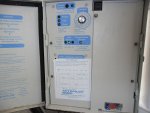How old do you think this AutoPilot system is?
- Thread starter Aquatica
- Start date
You are using an out of date browser. It may not display this or other websites correctly.
You should upgrade or use an alternative browser.
You should upgrade or use an alternative browser.
JamesW said:I'd say somewhere from 1996 to 2000.
wow. couldn't find a model name on it anywhere.
If I recall correctly, that looks similar to the last Lectranator model. The name Lectranator was changed to Autopilot in July 1995. Therefore, I'm thinking that somewhere from 1996 to 2000 is most likely correct.
PoolSean would probably know. Is there a serial number anywhere?
PoolSean would probably know. Is there a serial number anywhere?
It's an LS1000 model. It operated with either the RC-7 or RC-15 cell (SC-48 or SC-60, respectively). These first came out around 1992 and phased out around 2000-2001.
The LS1500 had a time clock mechanism on the right panel.
The LS2000 was a two-time clock, inhouse hardwired control panel system.
Positions 10 and 11 were the same.
I think if you opened the unit, on the right side, there may be a serial number written in black marker.
These were the first models made after we bought Lectranator in 1992.
The LS1500 had a time clock mechanism on the right panel.
The LS2000 was a two-time clock, inhouse hardwired control panel system.
Positions 10 and 11 were the same.
I think if you opened the unit, on the right side, there may be a serial number written in black marker.
These were the first models made after we bought Lectranator in 1992.
Poolsean said:It's an LS1000 model. It operated with either the RC-7 or RC-15 cell (SC-48 or SC-60, respectively). These first came out around 1992 and phased out around 2000-2001.
The LS1500 had a time clock mechanism on the right panel.
The LS2000 was a two-time clock, inhouse hardwired control panel system.
Positions 10 and 11 were the same.
I think if you opened the unit, on the right side, there may be a serial number written in black marker.
These were the first models made after we bought Lectranator in 1992.
wow cool. thanks the history lesson. this unit might still have been working but we decided to change it anyway. salt was too low. never got a chance to see if it worked.
It was a basic system, but utilized the Tri-sensor and manifold. When you power it up, the CELL light was used for the cell condition and diagnostics (along with the salt and temp sensor lights). But with newer power boards, if the salt was low, the cell light would flash red/green. If all was ok, it would turn green when the cell is energized. If the cell was dead or the power board was damaged, it would turn red.
If all are Green, you're good to go. If the salt or temp are red, you can bypass those lights and still have the system work fine. It's the dreaded red cell light that would mean a dead cell or cell cord, but if it's the circuit board, it makes it not worth fixing (the replacement board will cost as much as a new AutoPilot Nano System).
If all are Green, you're good to go. If the salt or temp are red, you can bypass those lights and still have the system work fine. It's the dreaded red cell light that would mean a dead cell or cell cord, but if it's the circuit board, it makes it not worth fixing (the replacement board will cost as much as a new AutoPilot Nano System).
opened it up and yes its an LS1000. The inside is like new. uses old resistor type technology. boards are in mint condition.
Thread Status
Hello , This thread has been inactive for over 60 days. New postings here are unlikely to be seen or responded to by other members. For better visibility, consider Starting A New Thread.
Similar threads
- Replies
- 3
- Views
- 528
- Replies
- 1
- Views
- 312
- Replies
- 3
- Views
- 331
- Replies
- 1
- Views
- 351


